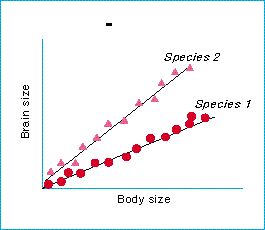Evolutionary developmental biology - How can we study morphological evolution?

Huxley's allometric graphs
The simpler of the two was largely invented by Huxley and is called allometry. Consider the graph opposite. If brain size increases more rapidly relative to body size in one species than in another, that is probably because the growth of the brain cell lines has been speeded up relative to the other cell lines in the body. In other words, there has been a heterochronic change between the species.
Allometry is an important method for describing morphological evolution. The body shape of a species can usually be partly represented in an allometric graph, and allometry provides a method of representing formally the shape differences between species. The axis of an allometric graph may or may not represent a true growth gradient in individual development. If it does, then the shifts in the graph slope between species will portray the changes in the development regulatory system that produced the evolution.
Figure: imaginary graph of allometric relationships between brain and body size in two species. Species 2 has a larger brain at each body size, and this could be because the growth of the brain cell lines have been heterochronically speeded up relative to the growth of other cell lines.
| Next |



